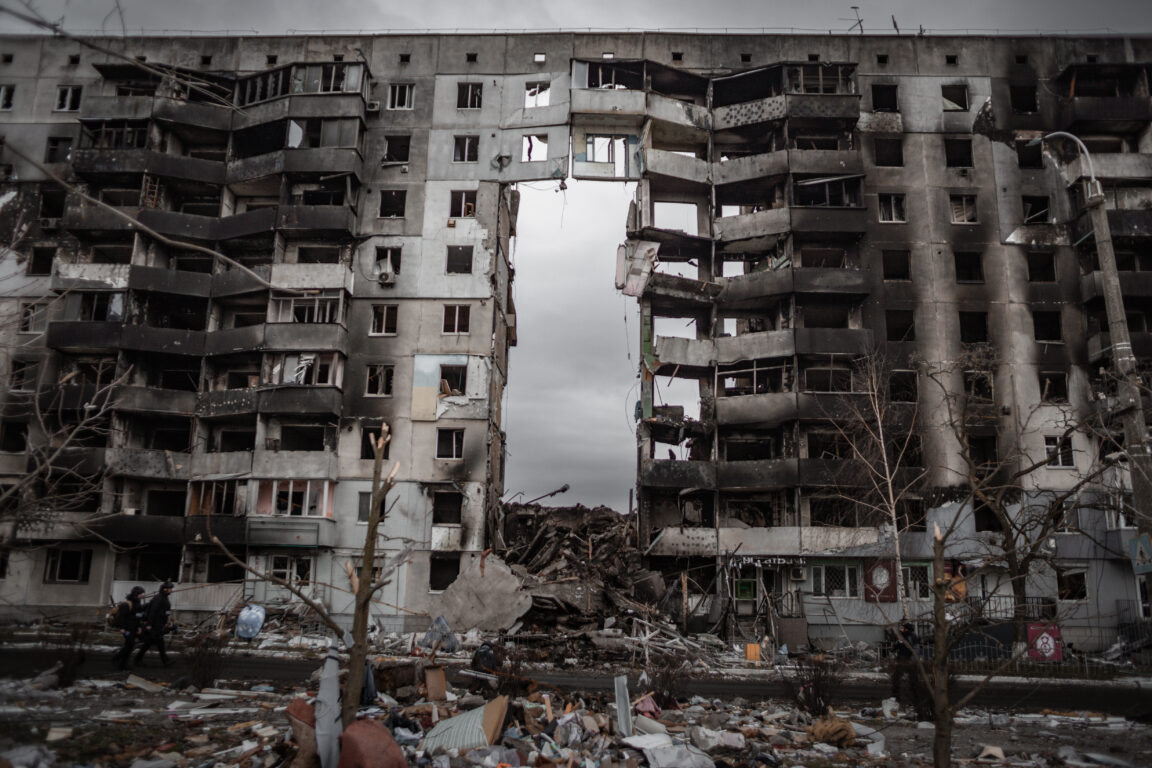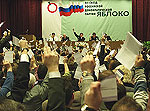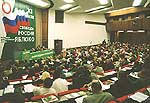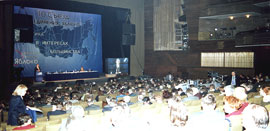On the Urgency and Inevitability of a Ceasefire
Grigory Yavlinsky’s web-site, 22.09.2023

Borodyanka, Kyiv district, Ukraine. March 2022 // Ales Ustsinau
THE SITUATION TODAY
One and a half years of hostilities have demonstrated that the largest armed conflict in Europe after World War II — the confrontation between Russia and Ukraine — will drag on for years and will be accompanied by never-ending fatalities and more and more destruction. To all intents and purposes this conflict will have no conclusive outcome; this is a no-win situation.
As long as there is no fundamental transformation of the political and economic system created in Russia in the 1990s1, as long as the regime in the country remains authoritarian and immutable, until the Russian Federation actually becomes a democratic state (and unfortunately this is not going to happen any day soon), there will be no material change in the Kremlin’s foreign policy.
Meanwhile the Ukrainian authorities declare that they will not stop and will not back down. Today, however, Ukraine is gradually starting to experience difficulties arising objectively in Western contributor countries: a build-up of budget problems, tension over issues of the combat readiness of the national armed forces and the exacerbation of domestic political differences. Support for Ukraine at current levels is not guaranteed.
The situation in September 2023 is such that a ceasefire has become inevitable: either the progress towards a ceasefire agreement will start immediately, or the parties will take this path at some point later on due to the continuing extensive casualties on the front line and victims among the civilian population — all the same, they will still conclude such an agreement2. At the same time, however, the price of each day of continuing bloodshed in the armed conflict is exceptionally high. In addition, the financial, economic and other costs attributable both to military expenses and the restoration of destroyed infrastructure will increase materially. The risk to the future of both countries will become even more real, in particular, the threat to the existence of Ukraine as an independent European state.
That is why we must repeat again and again: at present there is only one effective strategy to resolve the most serious international crisis in recent decades: an immediate ceasefire and after the signing of the respective agreement, a protracted and difficult search for political and diplomatic solutions.
However, negotiations on a ceasefire agreement should start immediately without any preconditions and continue until it has been signed. It is inevitable that the fighting will continue during these negotiations. However, this will already mark the start of efforts to bring an end to the bloodshed.
Some people hold that the negotiating process of spring 2022 cannot be resumed because the events in Bucha and war crimes committed in general changed the landscape to such an extent that negotiations are out of the question. Notwithstanding the seriousness of such considerations, this syndrome must be overcome if we are to rule out any further bloodshed. All the more so as the negotiations must be conducted based on a robust understanding of the undisputed need for an independent impartial investigation of each specific war crime, with the subsequent issue of an objective court decision. It is the absolute duty of every country and all international structures to prevent the commission of war crimes, regardless of the circumstances. The establishment of the truth and the administration of justice, regardless of the parties affected, is one of the safeguards of any future peace, in order to ensure that both soldiers and the civilian population are aware and confident about the unavoidability of liability for crimes. There can be no statutes of limitation in such cases and all existing legal institutions must be deployed to administer justice, and in instances where the necessary institutions do not exist, they must be created for this purpose.
OUTLOOK GOING FORWARD
As of mid-September 2023 one must acknowledge that the “large-scale” counteroffensive of the Ukrainian army — discussed extensively in the past — has not happened. Or at the very least, the offensive has not achieved any tangible results from a military perspective.
Russia has built along the entire front line multilayer defence fortifications — trenches, anti-tank obstacles, mine fields and other obstacles — and surmounting them is fraught for Ukraine with major losses of troops and military equipment. It is taking the Ukrainian armed force longer to surmount them than anticipated. In addition, judging by numerous publications in the mass media, the Ukrainian army is facing serious problems attributable to a shortfall in supplies of certain critically important ammunition and difficulties with the maintenance and operation of imported weapons of different standards.
At present the Russian army controls 120,000 square kilometres of Ukrainian territory. Over several months of the so-called counteroffensive, Ukraine’s armed forces have only recovered 220 square kilometres, in other words, 0.18% of all the territories occupied by Russia. At the same time, according to the estimates of the Western mass media in just one and a half years the losses of both sides in terms of fatalities and wounded already equal half a million people.
As demonstrated by historical experience, such conflicts do not end with the capture or liberation of territory through military force. One side may continue striking the population centres which have come under the control of the enemy through the use of aircraft, land-based and sea-based resources. In other words, tactical successes on the battlefield — a change in control of territories — in this case will not lead to the end of the hostilities.
In this confrontation we have witnessed a clash between Ukraine’s principled desire to lay the foundations of an independent and contemporary European-based state, on the one hand, and the idea advocated by Putin and the part of the Russian elite in power of the need to build a different world order and create a new global geopolitical system — a multipolar system based on neoconservative principles independent of American leadership, on the other hand. In other words, to all intents and purposes, this is a conflict between two fundamentally different views of culture, history and national identity, between the current world order and a future world order. And here Ukraine has ended up at the vanguard of a Western-oriented world order3. This is the crux of the matter.
And this is the reason why any territorial changes achieved through military force in this case will not end the confrontation. The hostilities can only lead to the establishment of a de facto line of control that neither side recognises as an international border.
Research shows that on average inter-state military conflicts lasting more year are not resolved for up to ten years4. Consequently, if we do not set the objective of an immediate ceasefire, then the following must be understood:
1. Such a type of armed conflict has its own internal logic: when a resounding victory cannot be achieved, the likelihood of an expansion of the area of the conflict increases progressively. In other words, the involvement of European countries and the USA in a major war becomes more and more likely — as was the case in both World War I and World War II (and here I am not even factoring in the risk that Russia might in certain circumstances resort to weapons of mass destruction — chemical, biological and nuclear; in this case, the underlying causes will change in principle).
2. Any repudiation of an immediate ceasefire implies de facto that the Ukrainian economy will not be able to recover because this is absolutely unrealistic if the hostilities continue: the air space of the country remains closed, as in the past the ports remain to a large extent blocked, the cities are under fire, men of working age are fighting on the front line, while millions of refugees do not want to return home from abroad. In such circumstances, serious investments in the country are impossible.
FIRST STEP
In these circumstances, we must achieve an immediate ceasefire. And it is only after this has been achieved that a long-term agreement will need to be developed that ends the hostilities. Clearly, this will not eliminate conceptual geopolitical differences. However, it will represent an attempt to bring an end to the bloodshed and destruction.
And we should not harbour any illusions here: the conclusion of any peace treaty or all-encompassing political agreement between Russia and Ukraine is impossible at present. In addition, after so many fatalities and destruction, the normalisation of relations between the countries is highly unlikely in the foreseeable future. A fundamental resolution of the conflict between Russia and Ukraine will only become realistic once an inevitable principled solution based on the model of the joint relations of Ukraine, Russia, Belarus and Europe becomes clear to all the parties and is implemented after hard work. However, naturally this solution is a long time away and the longer the armed conflict continues, the longer it will take to implement.
For the time being, we need to adopt decisions to save human lives in the here and now. In this sense, the Korean 1953 agreement is the most favourable option5 — a ceasefire agreement without any decisions on political issues.
Some people say that the situation after 24 February 2022 is such that Ukraine should on no account agree to any concessions, as this would be “unjust”. However, in real life there is no such thing as absolute justice. One can only seek to achieve such an ideal. However, when you embark on this path, you must not rule out the idea of concessions and compromise. Without mutual concessions, the killing will continue endlessly, while Ukraine will be destroyed. And in actual fact, is saving people’s lives and bringing an end to destruction really a concession? And what is more important – a fifth of the territory that you won’t be able to regain any time soon through military action, or people’s lives and the future of your country? The starting point here should be that compromises are possible for the sake of people’s lives and the future of the country. All the more so as in the current situation no territorial concessions will be conclusive, while official recognition of the new borders internationally is not anticipated. This is merely the ceasefire line.
Another delicate issue is the status of people on territories controlled by Russia. And here it will be necessary to proceed from the premise that if the hostilities continue, it will not be possible to save the lives of people on the front line, whereas if a decision on a ceasefire is adopted, it will be possible to try to reach an agreement on the terms and conditions for the stay or evacuation of people from these territories. At the same time, it must be borne in mind here that the status of people on territories controlled by Russia is different. You have one situation in Crimea, and a completely different situation in Donetsk and Lugansk. However, the status of people on these territories is incomparable with the status of people on the front line, the threats to the civilian population in connection with Russian control in these districts is incomparable with the risks faced every second by soldiers in the field of combat operations. As for the Zaporizhia Region and Kherson Region, then in the case of a ceasefire, it would be become possible to discuss the terms and conditions of the stay, evacuation or relocation of people in territories controlled by Russia. Finally, it should be borne in mind that the transfer of control of the territories to Ukraine’s armed forces does not imply a safe and normal life for a significant proportion of the local population who were under the control of the Russian Federation. Here it will also be necessary to reach agreement on the terms and conditions of the lives and protection of this group of citizens.
It goes without saying that the decision to sign a ceasefire agreement will be adopted by Ukraine. However, the reality is that the Western countries systematically providing weapons to Ukraine on a regular basis, which have financed and continue financing the Ukrainian economy, will be required to participate in some way or other in the elaboration of the key political solution determining the scale and timeframe of the hostilities in Ukraine — their continuation or termination. All the more so as the experience and possibilities of diplomacy in these Western countries are incomparable with Ukraine’s political resources.
Nevertheless right now the USA, the European Union and NATO are not making any effort to seek and develop political and diplomatic solutions to bring an end to the hostilities. Virtually nothing is being done to prepare at the very least a preliminary version of a ceasefire agreement. The delay in understanding, and possibly, the principled incomprehension of the United States as to the need for a ceasefire, complicates the situation significantly, because the continuation of the hostilities is a path to transforming Ukraine into Afghanistan, Iraq or Libya with all the ensuing consequences.
In addition, Western countries are not doing anything at government level (at the very least, not openly) to reassess the structure of European security, in order to minimise the likelihood of the outbreak of a similar crisis in future.
One of the key arguments of the advocates for continuation of the hostilities in Ukraine is that if the Russian army is not stopped in Ukraine, then not only will countries neighbouring Russia be at risk: so will Eastern Europe. However, even if we assume that it is impossible either today or in the near future for the Ukrainian armed forces to advance to the 1991 borders, by contrast Russia — if one takes into account the scale of the country, the size of its military industrial complex, mobilisation capacities, the assistance of China and the Democratic People’s Republic of Korea (which will become far more perceptible if such a scenario were to develop) — will only need a few years to restore its military potential. If the current economic and political system is maintained and the regime draws on accumulated experience, Russia will once again be able to start the conflict both with Ukraine and possibly other neighbouring countries. We don’t need to look far for examples: the second Chechen war started two years after the end of the first war and the signing of the peace treaty between Russia and the Chechen Republic — and continued for another ten years6. (Let me repeat here that we are putting to one side the possible application of weapons of mass destruction.) Therefore, the continuation of hostilities will only engender the loss of countless lives and will not “stop” anything or anyone in any case. Ukraine cannot annihilate Russia, Ukraine cannot subjugate Russia and force the Kremlin to sign an act “of unconditional surrender” and abandon its geopolitical fantasies.
In order to reduce the likelihood of any repeat conflict and the risk of the expansion of the area of the conflict in the east of Europe, today we must no longer dream and fantasise, but must instead secure an immediate end to the hostilities. In addition, proactive and never-ending diplomatic and political efforts are required to seek the initial conditions for mutual understanding, above all, along the lines of the USA/European Union — Russia; USA/European Union — China — Russia; USA/European Union — India — Russia. Mediation is also possible — for example, by Israel. This work is complex, but unavoidable. Success is not guaranteed in the foreseeable future. However, there are no other options. The later the process starts, the more people will die and the higher the risks of direct confrontation between NATO and Russia in Eastern Europe.
Let me repeat. The situation is such that there are no good options. There are only bad and very bad. This option (ceasefire + diplomacy) is bad, as it has clear shortcomings which are understandable to anyone. However, all the other options are far worse. In the long term security in Europe can only be achieved through the creation of a common economic and political space from Lisbon to Vladivostok.
However, for the time being there are principled contradictions between Russia’s current leadership, on the one hand, and the West and Ukraine, on the other hand, to the extent that they are so serious and profound, while the scales of the territorial claims are so material that the crisis cannot be resolved through military force. It will not prove possible to return in full or retain these lands in the conflict zone without numerous victims both among the military and the civilian population. People will die every day not only on the battle field, but as a result of the missile and artillery fire of residential districts, persecution and diseases which proliferate at a time of military operations. This will continue until a ceasefire agreement has been concluded.
As General Mark Milley, Chairman of the Joint Chiefs of Staff of the USA, said in an interview with the Washington Post in August this year: “This offensive [Ukraine’s armed forces] is going to be long, is going to be bloody and is going to be slow, and it’s a very, very difficult fight”7.
George Clemenceau, the Prime Minister of France in 1919, said that it is harder to make peace than to wage war.
When the conflict in Ukraine approaches something similar to an end, peace-building will become a separate vast and complex objective.
P.S.: On different platforms, politicians, political scientists, commentators, bloggers and journalists state that it is not realistic to conclude a ceasefire agreement in the current environment… And this is understandable. Today, neither Putin, nor Zelenskyy, nor Biden, nor high-ranking bureaucrats in Brussels want to discuss a ceasefire initiative. If that is the case, why talk and write about this constantly? Because there is nothing more important than saving lives. And this is something that society must demand and achieve. We need to form such public understanding, namely such a mood among the absolute majority of our citizens8. People must demand that politicians save lives, engineer a ceasefire, hold peace negotiations. However, today we have a long way to go before we reach such an understanding, while the price of each day [of delay] is the loss of lives and the appearance of new cripples. That is why we talk and write about this.
1) Yavlinsky G. Russia-2022: Underlying Causes // Official website of the economist and politician Grigory Yavlinsky. 2 July 2022. Access (checked on 22.09.2023).
2) There was a window of opportunity to effectively work to reach a ceasefire agreement in November 2022 after the Ukrainian operations in Kharkiv and Kherson Regions. This period continued until March 2023.
3) “This will be a war with the entire Western world in Ukraine” // Radio KP. 14 July 2021. Access (checked on 22.09.2023).
4) Data of the Centre for Strategic and International Studies for the Period from 1946 to 2021, collected by Uppsala University. See Palik J., Obermeier A. M., Rustad S.A. Conflict Trends: A Global Overview, 1946–2021 // PRIO Paper. Oslo: PRIO. 2022. Access (checked 22.09.2023).
5) Yavlinsky G. How to Win the War // Official website of economist and politician Grigory Yavlinsky. 3 August 2023. Access (checked on 22.09.2023).
6) The hostilities continued in the Chechen Republic until 2009. The counteroffensive officially ended in April 2009. See Schwirtz M. Russia Ends Operations in Chechnya // The New York Times. 16 April 2009. Access (checked on 22.09.2023).
7) Caldwell L. A., Meyer T. Gen. Milley on Ukraine, Tuberville and ‘wokeness’ // The Washington Post, 18 August 2023. Access (checked on 22.09.2023).
is Chairman of the Federal Political Committee of the Russian United Democratic Party Yabloko, Vice President of Liberal International, PhD in Economics, Professor of the National Research University Higher School of Economics.
Posted: September 25th, 2023 under Foreign policy, Governance, Human Rights, Russia-Eu relations, Russia-Ukraine relations, Russia-US Relations.







